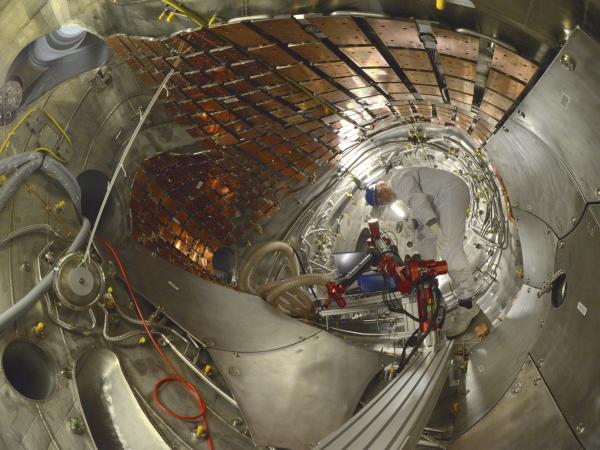
This wide-angle view inside the Wendelstein 7-X stellarator (April 2013), shows the stainless cover plates, and the water-cooled copper backing plates (eventually covered by graphite tiles) that were being installed as armor to protect against plasma/wall interactions.
Max Planck Institute for Plasma Physics
Department of Energy funds Porkolab and Terry to advance fusion studies on the world’s largest stellarator
August 29, 2018
As part of an initiative to support the development of nuclear fusion as a future practical energy source, the U. S. Department of Energy is renewing 3-year funding for two PSFC projects on the Wendelstein7-X (W7-X) stellarator at the Max Planck Institute for Plasma Physics in Greifswald, Germany. The largest stellarator in the world, W7-X was built with helically-shaped superconducting magnets to investigate the stability and confinement of high temperature plasma in an optimized toroidal configuration, ultimately leading to an economic steady state fusion power plant. With plasma discharges planned to be up to thirty minutes long, researchers anticipate W7-X will demonstrate the possibility of continuous operation of a toroidal magnetically confined fusion plasma.
PSFC Principal research scientist Jim Terry is being funded to build and install on the stellarator a new diagnostic called “Gas-Puff Imaging.” The diagnostic measures the turbulence at the boundary of the hot plasma by taking images in visible light at 2 million frames per second. The light is emitted as the plasma interacts with gas that is introduced locally at the measurement location. This fast frame rate allows researchers to see the dynamics of the turbulence. Observing plasma turbulence in fusion devices will help researchers understand how to better confine the plasma, while at the same time handling the plasma’s exhaust heat. The new funding of $891K is a renewal of a 3-year grant that ran from 2015-2018, during which time this diagnostic was designed. Terry’s team includes PSFC research scientist Seung Gyou Baek, as well as graduate student Sean Ballinger (Nuclear Science and Engineering) and undergraduate Kevin Tang (Physics), both of whom have had extended stays on-site at W7-X.
Over the past three years, Prof. Miklos Porkolab (Physics) and his team have designed and installed a “phase contrast imaging” (PCI) diagnostic on W7-X. PCI is a unique interferometer method using a continuous wave coherent CO2 laser and additional specialized optical components that allow it to measure instantaneously the turbulent density fluctuations in the core of the hot plasma. Using data collected over the past year, the team is analyzing the measured turbulence levels and comparing them with predictions of state-of-the-art gyrokinetic codes, assessing how turbulence contributes to the loss of energy and particles in an optimized stellarator. The renewal of this 3-year grant, for $900K, will fund not only personnel to continue analysis of experimental data, but also necessary upgrades to allow simultaneous imaging of core and edge fluctuations, making the PCI diagnostic versatile in its ability to measure a wide range of waves and instabilities. In addition to Porkolab, members of the team include former PSFC staff scientist Dr. Eric Edlund, now assistant professor at SUNY Cortland, who played a key role in the design of this diagnostic, and PSFC postdoctoral associate Zhouji Huang, stationed on-site in Greifswald. PSFC research physicist Dr. Alessandro Marinoni and postdoctoral associate Evan Davis (both stationed at DIII-D, an MIT collaboration in San Diego) also contributed to the project during the summer of 2018.
Topics: Magnetic fusion energy, Technology & engineering, Plasma heating & current drive, Plasma turbulence, Tokamak & stellarator collaborations, Miklos Porkolab, Paul Bonoli